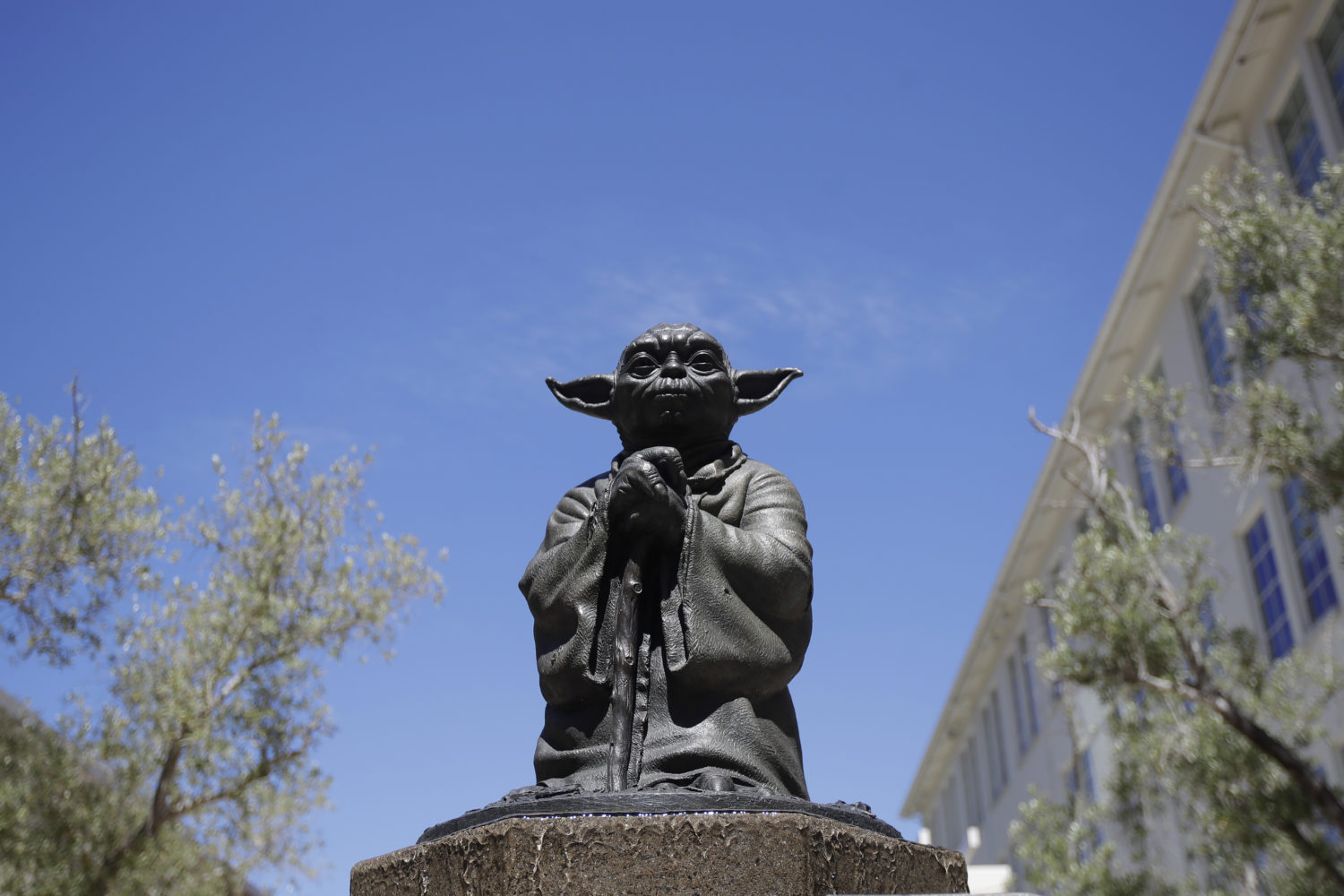After more than 40 years, the Force is still with us. “Star Wars” is everywhere.
Among the journalists we know, none is more knowledgeable about the creative legacy of “Star Wars” than Jason Fry. As an independent author, Jason has written more than 30 “Star Wars” books and short stories. He is also the author of his own space adventure series, “Jupiter Pirates,” published by HarperCollins.
Before his literary journeys into space, Jason spent 13 years at the Wall Street Journal online as a reporter, editor, columnist, and blogger. He has been a frequent contributor to Poynter, serving as a writer, editor and visiting teacher.
I interviewed Jason because I thought he could teach me some things about “Star Wars” and the writing craft. We have known each other since Jason was 3 years old.
From a storytelling point of view, if you could focus on one or two story elements that have created and sustained the “Star Wars” franchise, what would they be?
I’d pair the hero from humble circumstances and opposites attracting. Luke Skywalker is a classic fairy-tale hero down to the humble pedigree that hides his true importance, which is a fantasy we all have about ourselves at some point as kids. That character and his journey give us the through-line for the classic trilogy, and his father Anakin’s very different journey from similar origins is the spine of the prequels.
But I think the second point is important, too. George Lucas gets plenty of grief for his dialogue, but when I was a young writer, he taught me something pretty important in discussing the different personalities of Luke and Han Solo. To quote Lucas himself, in Laurent Bouzereau’s “Star Wars: The Annotated Screenplays”: “You always try to set up a character, and then you create an opposite, another character who has a different point of view on everything so that they can argue. If you have two guys that are the same, talk the same, think the same, and feel the same, then there is nothing for them to talk about, ever.”
I could go to my parents’ attic and bring back boxes of youthful stories that don’t go anywhere because I hadn’t figured this out. It’s a point I now think about as early as the outline phase of a project: Do I have two characters working together on a goal, or sharing pages for a long part of the narrative? If so, do they see the world very differently? Want different things? Disagree on how to achieve that goal? I need to feel confident that they could hold the readers’ attention by being themselves.
“Star Wars” is a lot more than that, of course — it’s got good and evil and complicated family legacies, not to mention cool spaceships and lightsabers and blasters going pew pew. But every story comes down to characters who see things differently colliding and making sparks fly.
Popular literary franchises seem to grow from the ability of the author to create an alternative universe. I’m thinking of Frank Baum with Oz, Tolkien with Middle Earth, Martin with “Game of Thrones,” Rowling with Harry Potter, maybe Ian Fleming with James Bond. What kind of writing gene or genius is required to create such a world?
World-building is something fans respond to, and it can drive a deep, loyal engagement with a franchise. That’s definitely true of “Star Wars,” where books, comics, role-playing games and videogames have filled in an enormous amount of history and detail about the galaxy far, far away. I ought to know – my friend Dan Wallace and I felt an OCD need to understand the geography of the “Star Wars” galaxy and wound up writing “Star Wars: The Essential Atlas” together. Yes, I helped map a fictional galaxy because on some level I found it soothing. I agree that’s at least mildly bonkers. So when does world-building work and when doesn’t it? That’s an interesting question. I think it comes down to an author’s success in creating a feeling of authenticity.
How to create that feeling is something I’m still figuring out as a writer, but I think it helps to do it quietly. A lot of fantasy epics hit you with a big info-dump around Chapter 2 that amounts to a character in a tavern gravely pontificating about “the Wibglibber dynasty that rose to power in Year 4,522 of the Eighth Age and was cast down by the Shadows of Mul’graz’taga after they found the Scepter of Pufnatz in Year 803 of the Ninth Age.” That’s not going to work unless your goal is to exhaust the reader, and it’s not how the authors you mention do it. Tolkien, for example, constructs Middle-Earth out of bits of dialogue and notes on everything from surrounding plant life (goodness is there a lot of tree identification in Lord of the Rings) to the carvings on old ruins. The world he has in his head accretes around you bit by bit until you believe in it.
“Star Wars” does the same trick in a more visual way. George Lucas gave us a lived-in universe, which flew in the face of what we expected from a space movie in 1977. The Millennium Falcon isn’t a flawless, factory-new ship where crew members in crisp uniforms gently tap glowing lights on a clean white bridge. It’s rusted and pitted and missing parts and Han Solo gets it working by whacking a panel with a loose wire. The whole galaxy feels lived in, like it has a history — which I think naturally made fans curious about that history.
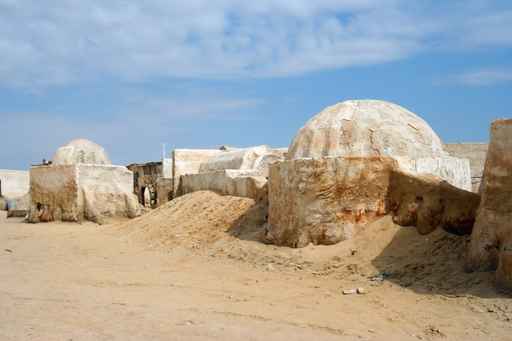
An abandoned set that depicted Tatooine in the Star Wars movies. (Associated Press/Fotolia)
I learned in literature class that ancient epics tended to begin “in medias res,” in the middle of things. When I went to see the original “Star Wars” movie, I assumed it was number one — not number four. What is the value of such a strategy? Can a journalism story begin “in medias res”?
Well, the hoary old inverted pyramid basically does this, doesn’t it? Here’s what just happened, now let’s explain how we got here. If you want to explain our current dysfunctional government, you’re more likely to hook the reader by starting with podium-thumping about a shutdown or chaos in the House than you are if you begin with the Founders arguing about proper balance in a bicameral legislature.
But I think it can work in other journalism forms as well. Here’s a vivid portrait of a man living under a bridge — who turns out to be a former football star with CTE. Now I’m going to tell you how that happened. That’s “in media res.” Start with the good stuff, win the trust of the audience and sit back and tell them the story.
Sequels are rarely as popular as the originals, yet most folks think that the best movie in the series so far is “The Empire Strikes Back?” Do you agree? And if so, what qualities does that part of the story have that others lack?
“The Empire Strikes Back” is my favorite … but then I’m a 46-year-old dude, so Vegas would only give you like 9-8 odds on that one. Why does it work? It’s got amazing special effects, writing that derives its energy from banging interesting characters together and what might be the best reveal in cinematic history. (At the very least it’s the most culturally influential one.)
But I think the real lesson of Empire for storytellers is that it’s willfully contrary in ignoring every rule for making a sequel. The ensemble cast that fans loved so much in Star Wars is together for two very small scenes and then broken up. The big battle comes at the one-third mark, not at the end. And our heroes spend much of the movie getting their butts kicked. The Empire wins a huge victory on the ice planet, Han is captured and hauled off by a bounty hunter, Luke gets manhandled by Vader and is left missing a hand and saddled with a horrible family secret, and even poor C-3PO gets shot. Empire shouldn’t work — it should be a total downer of a movie — but it does.
I think that lesson is worth keeping in mind. You should listen to your editors and trusted sounding boards about what they think works or doesn’t work in the story you have in mind. That’s valuable feedback. But if that feedback pushes you into formula and too far away from whatever vision you found compelling in the first place, push back. Be true to the story that bugged you to the point that you needed to let it out into the world.
“Star Wars” comes from a familiar genre — the space opera — that harkens back to the Buck Rogers and Flash Gordon serials of the 1940s. It also feels like a converted “horse opera” — a cowboy movie set in space. What have creators done to tweak the genre so that it seems fresh rather than derivative?
I think that a lot of storytelling — maybe all of it — begins when we mash up moments and tales and influences that have resonated with us and use them as raw material for something we hope is new but also feels familiar enough to resonate with our readers. We all do that; a lot of the skill of storytelling, it seems to me, lies in how (and how much) we transform that raw material. In Lucas’s case, he took comic books and westerns and Saturday-morning serials and WWII flying movies and samurai films and his own experiences and sliced and diced them and came out with “Star Wars.”
One thing I think elevates “Star Wars” above its genre antecedents is Lucas was interested in the idea that hero stories follow a template — an idea that Joseph Campbell popularized. I think the importance of that gets a little overblown when talking about “Star Wars,” to be honest. But it’s definitely in there — Lucas did talk about “Star Wars” as a self-aware myth and as a replacement for the westerns he loved as a kid.
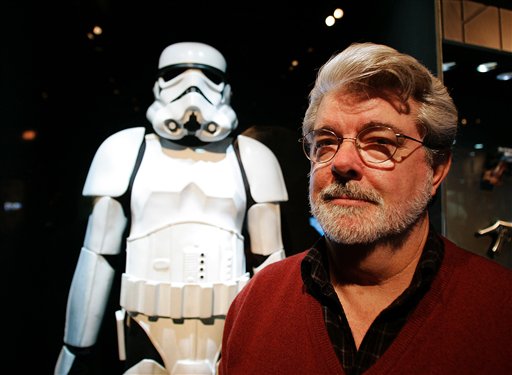
In this Oct. 22, 2005 file photo, filmmaker George Lucas poses in front of a Stormtrooper exhibit at the Museum of Science in Boston. (AP Photo/Winslow Townson, File)
“Star Wars” has also succeeded in spite of its many flaws, some of which have been articulated by fans of the franchise. Some fans think the Ewoks are too cute, and then there was the general denunciation of Jar-Jar Binks. It’s great to have a franchise that survives some of its biggest mistakes. What can writers learn from that?
Poor Jar-Jar. He’s relatively low on my list of favorite “Star Wars” characters, to be diplomatic about it, but I thought the Clone Wars TV series did some interesting things with the character. In one episode he’s forced to play hero and turns out to be pretty sympathetic — he’s the Fool, who at heart is a tragic character. Then there’s another Clone Wars episode that’s basically a buddy-cop adventure starring Jar-Jar and Mace Windu, Samuel L. Jackson’s Jedi from the prequel trilogy. Mace is about as thrilled to be partnered with Jar-Jar as you’d expect, and the results are pretty entertaining.
Same thing with the Ewoks — I wrote a book called “The Essential Guide to Warfare” and included an account of the battle in “Return of the Jedi” from a stormtrooper’s perspective, featuring stuff that happened off-screen — such as Ewoks firing arrows dipped in nerve toxin and wielding stone clubs and learning how to fire blaster rifles. That stormtrooper didn’t think the Ewoks were cute at all.
In both cases I think what’s interesting is the same material was used to tell new stories, ones that made you think of established characters differently and that worked for a different part of the audience, without undermining the originals. If you have something you see as a challenge or a limitation, see if you can use that to push yourself as a storyteller and come up with something interesting. Or, alternately, see if someone else’s interpretation unlocks something you hadn’t thought of.
When it comes to fantasy and science fiction, there is a temptation to look at stories as veiled allegories of our own time. Back in the early 1950s, it was pretty easy to identify “Godzilla” as an emblem for post-nuclear Japan. “Star Wars” seems to be immune from this, or am I missing something?
The original “Star Wars” was shaped by the early and mid-1970s, when it was coming together in Lucas’s head. The original Emperor was very much a Nixon figure, and there’s a distorted reflection of Vietnam in the Ewoks fighting the technologically superior Empire, which originated as an idea for the first film.
But those allegories are pretty veiled — “Star Wars” was a break from the conspiratorial, emotionally arid movies of the 70s, which some critics will always think Lucas and Steven Spielberg should apologize for. Mostly it hearkens back to the westerns and serials we discussed, and not to any current events of a given time. Which I think has helped keep it from feeling dated. The morality of it, and the choices the characters face, work as well now as they did then.
Jason, of the many “Star Wars” characters we have encountered over almost three decades, which ones do you think are the most interesting, memorable, or fully realized?
For me it begins with Luke and Han, who I brought up at the beginning as a great pairing — Luke’s the idealistic, naïve kid out to save the galaxy, while Han’s the cynical survivor who’s constantly fighting a losing argument with his conscience. Han’s definitely the most fun, but Luke’s journey is the really interesting one. He discovers the truth about his father, and eventually saves the galaxy by rejecting his teachers’ advice. Yoda and Obi-Wan think he has to kill Vader, that Anakin Skywalker is now more machine than man, but Luke wins by showing mercy, and bringing out the good that’s still in his father. I love Leia too — give Lucas credit for a character who did a lot to break down antiquated notions about gender — but as a teenaged princess/senator/revolutionary she’s tougher for an audience to relate to immediately.
And some of the characters work because they’re mysterious. Take Boba Fett in the original trilogy — he has four lines, but his clinking spurs and battered helmet made him an icon.
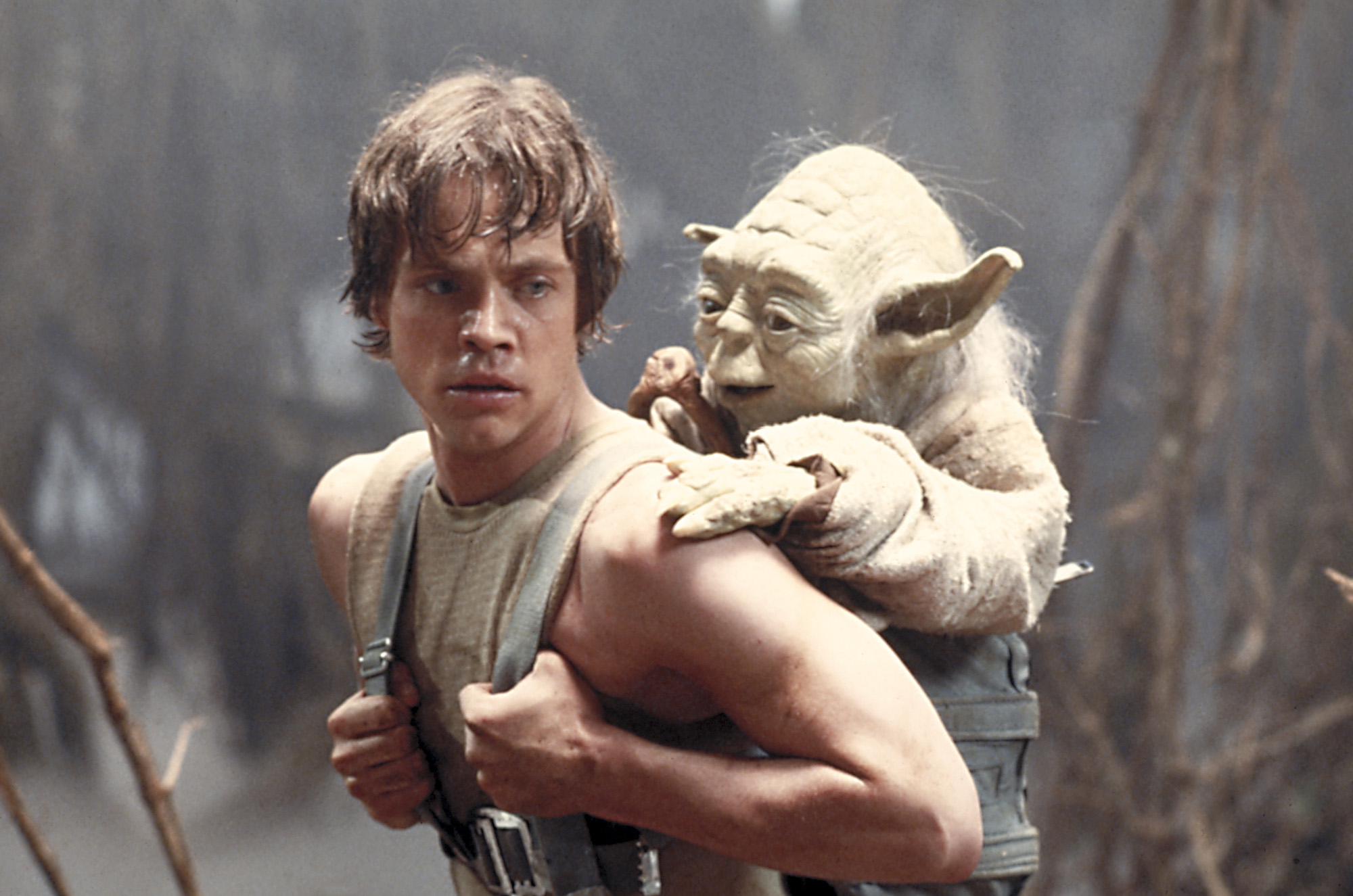
This image provided by Lucasfilm Ltd. shows Mark Hamill as Luke Skywalker and the character, Yoda, in a scene from the 1980 movie “Star Wars Episode V: The Empire Strikes Back.” (AP Photo/Lucasfilm Ltd.)
In addition to the movies, the “Star Wars” franchise has generated a gazillion dollars in merchandise and additional literature. There is fan fiction, of course, but also the literature of an “expanded universe” to which you have contributed significant works. What’s the key to taking a familiar character, like Luke Skywalker, and advancing his story?
I think it’s understanding what makes the character tick. Which can be harder when you think you’re really familiar with that character.
Working with iconic characters is a challenge — there are tons of fans who have spent their entire lives with the adventures of Luke Skywalker, and they have really finely tuned radar for how he’s supposed to act and sound. If that’s a little bit off, they’re not just thrown out of the story but pissed at you. I know because I’m one of those fans — so when I sat down to write “The Weapon of a Jedi,” my Luke book for kids, I kind of gulped and thought, “I better not screw this up.”
One reason I was a bit nervous was I had to admit I’d never really got Luke as a character. As a kid I was definitely on Team Han — the Jedi didn’t seem to have any fun, while Han and Chewie got to zoom around the galaxy drinking in cantinas and blasting people and being pirates.
So the first thing I did was watch the movies again, but this time I really zeroed in on Mark Hamill’s performance — how he carried himself, how he spoke, and how he responded to other characters’ actions.
That helped, but not as much as a story Hamill told about filming “Star Wars.” They were shooting the scene where Luke and C-3PO find the escaped R2-D2. Hamill played the scene angrily, and Lucas said cut. “It’s not a big deal,” he told him quietly. Hamill didn’t agree, so on the next take he played Luke with what he thought was ridiculous understatement, figuring Lucas would say cut again and they’d work it out. Lucas thought that take was perfect, and Hamill thought, “Oh, I get the character now.”
Couple that with a really interesting online comment I found from a Luke fan, who talked about how Luke is gentle, more apt to react instead of act. I thought about that and found myself nodding. In the original “Star Wars,” Luke destroys the Death Star by letting go and allowing the Force to guide his shot. In “Return of the Jedi,” he defeats the Emperor by throwing away his weapon and showing mercy to his father. “The Empire Strikes Back” is the movie where he’s most like a conventional action hero — he ignores everyone’s advice and rushes off to save his friends from Darth Vader. So what happens? He gets thrashed by Darth Vader and his friends have to go back and save him.
Once I’d worked that through, I was able to sit down and write — about a character I now appreciated a whole lot more.
You have created now three novels of your own in this genre, under the main title “Jupiter Pirates” series. (Fun to read, by the way!) How did you achieve escape velocity from the “Star Wars” franchise in order to create these?
Oh, thank you — I’m glad you’ve enjoyed them.
I was 8 when I saw the original “Star Wars,” so I’ll never achieve escape velocity from it! “Jupiter Pirates” has a lot of “Star Wars” in its DNA — hell, every story I tell has a lot of “Star Wars” in it. But thinking how “Jupiter Pirates” shouldn’t be like “Star Wars” helped shape it, too. For instance, I knew I wanted to tell a space fantasy that was confined to our solar system, and that had neither aliens nor robots – to me, those familiar space-opera tropes felt like “Star Wars” turf, and I thought that something interesting might come from denying myself access to them.
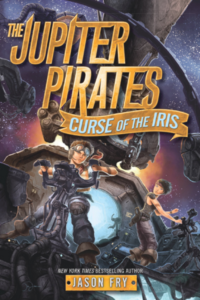
“The Jupiter Pirates,” by Jason Fry
It’s also a question of which stories and themes go into the blender for your own storytelling. I’ve always loved Patrick O’Brian’s Aubrey-Maturin books, and knew I wanted shipboard life in “The Jupiter Pirates” to hearken back to the “wooden hulls and iron men” tradition, though with iron women getting center stage, too. I’d also watched “The Sopranos” years after everyone else did and really enjoyed it, particularly the sense of a dying way of life and the generational conflict it spawned.
“The Jupiter Pirates” is about a family of space pirates who have to learn how to fight legally as privateers. The grandfather’s an unreconstructed old pirate, the kids obey the law while hearing about the past, and their parents have one foot in both camps. It’s no mystery where that inspiration came from: Tony Soprano’s father was an old-style mob boss, his daughter was embarrassed by the whole thing, and he was caught between the two. (If you’re curious, I wrote more about influences on the series here.)
My publisher touts “Jupiter Pirates” as “Battlestar Galactica meets Treasure Island,” but I’ve always thought of it more as “Patrick O’Brian meets The Sopranos.” But hey, their version isn’t wrong, and my tagline would probably scare parents looking for a kid’s book. So what the heck. At least we can agree there’s plenty of “Star Wars” in there.
This article was originally published on Dec. 14, 2015.

